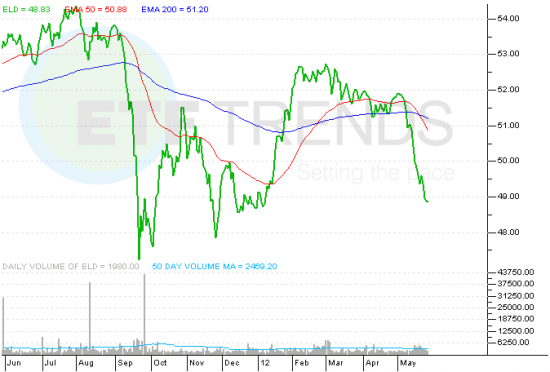Emerging Market Bond ETFs HeadToHead EMB v
Post on: 13 Август, 2015 No Comment

Emerging Market Bond ETFs Head-To-Head: EMB vs. PCY
As any experienced investor knows, bonds play a critical role in the portfolio construction process, and should generally make up a significant portion of any well-diversified portfolio. While the fixed income investing scene has historically been dominated by Treasuries, a prolonged period of low interest rates (along with the Fed’s refusal to even hit at raising rates any time soon) has caused some investors to go in search of more attractive yields. Furthermore, increasing piles of debt on the U.S. government’s balance sheet has some investors wondering is a downgrade or default is indeed a possibility. Treasuries. once a source for risk-free return, have become a return-free risk. For investors seeking more attractive yields, foreign bonds, specifically those in emerging markets, have been gaining favor as of late. These bonds are not risk-free by any means, but offer a significantly higher current return to compensate; many sovereign emerging market bonds pay coupons in excess of 10%, compared to 4% and under for many government bond ETFs. This disconnect can largely be attributed to the higher inflation rates prevalent in many emerging markets. as well as the higher level of perceived risk that these bonds have. However, many emerging markets actually have solid balance sheets and seem far more capable of repaying debts than some of their more heavily-indebted counterparts in the developed world .
Currently, there are two options in the Emerging Market Bond ETFdb Category. including the iShares JP Morgan Emerging Bond Fund (EMB ) and PowerShares Emerging Markets Sovereign Debt Portfolio (PCY ). While these funds offer similar exposure, they are far from identical, and investors should know the main differences between these two increasingly popular funds.
Index
EMB follows the JPMorgan EMBI Global Core Index. a benchmark designed to track the total return of a U.S. dollar denominated emerging markets debt benchmark that focuses on actively traded debt instruments. Meanwhile, PCY follows the DB Emerging Market USD Liquid Balanced Index. which tracks the potential returns of a theoretical portfolio of liquid emerging markets U.S. dollar-denominated government bonds issued by approximately 22 emerging-market countries. The countries in the index are selected annually pursuant to a proprietary index methodology and the membership list is rebalanced quarterly.
Holdings
While both funds target bonds from similar countries, they allocate their resources very differently, starting with the number of holdings for each fund; EMB holds 57 different securities, compared to just 31 for PCY. EMB also focuses on slightly safer bonds; the average credit rating of its securities is BBB compared to BB for PCY. Another key difference to keep in mind is interest rate sensitivity; PCY has a longer effective duration, nearly one year longer than EMB (7.75 years to 6.87 years). For individual country holdings, there are some stark contrasts between the two funds. No one country makes up more than 5% of PCY while EMB has more than 10% of its assets in both Russian and Brazilian bonds. PCY also has more of tilt towards Latin American countries while EMB has slightly more of a focus on emerging Asian economies instead.
Performance and Fees
Perhaps the biggest selling point for emerging market bond investors is the impressive yields that these funds offer. PCY currently offers a 30 Day SEC Yield of 5.8% while EMB’s yield is about 5.2%. In terms of price appreciation, the two emerging market funds have performed similarly thus far in 2010; PCY has gained about 2.9% while EMB is up 2.6%. Both funds have performed very well over the last year, adding more than 20% during that period. For fees, EMB charges an expense ratio of 0.60% compared to 0.50% for PCY.
Verdict
While offering similar exposure, there are some key differences that investors should keep in mind when considering an emerging market bond ETF. EMB is a far more liquid fund, so it may be more appropriate for investors concerned about exiting a position quickly. The fund also has a higher credit rating, and its assets are more spread out among bond issues.
PCY, on the other hand, could be a good choice for investors interested in minimizing fees. The fund could also offer a higher risk/reward dynamic due to the lower credit rating of its bonds. It could also be a better choice for investors that want to avoid Russia. since Russian bonds receive the largest allocation for EMB but only makes up less than 4% of PCY.
For an in-depth look at emerging market bonds, check out our definitive guide to emerging market bond ETF investing. For more ETFs head-to-head, make sure to sign up for our free ETF newsletter .
Disclosure: Eric is long PCY
3A%2F%2Fwww.ftjcfx.com%2Fa9103nswkqo9DEBHBJJ9BAGACJDA /%














